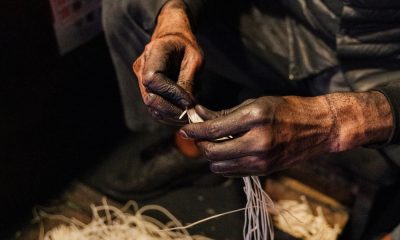Articles
Battling floats and burning horses
One of Japan’s most dangerous festivals is a spectacle of blood, sweat, and no small amount of tears. This is one matsuri you won’t want to miss.
The first clue that Omihachiman is in festival mode comes courtesy of the hollers and ululations that are carried across the deserted baseball pitch as we wait to cross the road into the shade of shin-machi. I smile in anticipation. The sky is a deep blue, suggesting summer heat but not quite yet delivering. It’s certainly feeling spring-like, though, and this is reflected in the lifted spirits of the day’s revellers. As we pass a cho (neighbourhood team) dressed in custard-yellow uniforms, the konnichiwas ring out and I’m offered a can of beer.
We’re at the Sagicho Matsuri in Omihachiman, Shiga. Held annually in mid-March, this incredible festival features beautifully decorated floats that compete in violent battles, only to be spectacularly burned at the end. Local lore has it that Oda Nobunaga dressed as a woman and sneaked over from his neighbouring castle in Azuchi just to see the festivities. Unsurprisingly, this event has been listed as one of the top three most dangerous festivals in Japan.
Eager to get close to this tantalizing action, we approach the torii gate to Hachimangu Shrine. The choral shouts of cho yare, cho yare (let’s do it!) and the shriek of whistles cut the crisp air and the hazy scent of takoyaki permeates the visual spectacle that greets us. Floats depicting the sign of the Chinese year, built of bamboo and decorated entirely with dried food (including tiny fish heads on one float), are surrounded by a team of devoted constructors and supporters. One team includes a tall American named Eric who tells me, “It’s a day of festive lunacy to most, but to those of us who built these floats it is a deep source of pride. I’ll be crying later.”
A young man stands on a float. Wearing split-toe shoes, baggy white pants and his team’s blue jacket, he blows a whistle as the float is hoisted onto the men and women’s shoulders and charged forward. They are met by an opposing cho and there is the crunch of smashed beans and the snap of splitting bamboo as the floats battle for the upper hand. Cheers and groans illuminate the scene until one float is forced onto its side. The victorious team climbs up the beams and dances wildly.
 When night falls, we find a spot on the wall opposite the shrine building. The 14 floats parade into the shrine and 2-litre unlabelled bottles of sake are passed between the bearers. An unofficial contest begins as the teams spin round and round and vie to be the final float standing. Finally they settle the floats in a neat line and an official steps up with a torch and lights the cherished mikoshi. The team frantically tries to halt the flames but eventually succumbs to the inevitable outpouring of emotion that each year signifies the end of sagicho matsuri as the blazing heat warms the grateful spectators.
When night falls, we find a spot on the wall opposite the shrine building. The 14 floats parade into the shrine and 2-litre unlabelled bottles of sake are passed between the bearers. An unofficial contest begins as the teams spin round and round and vie to be the final float standing. Finally they settle the floats in a neat line and an official steps up with a torch and lights the cherished mikoshi. The team frantically tries to halt the flames but eventually succumbs to the inevitable outpouring of emotion that each year signifies the end of sagicho matsuri as the blazing heat warms the grateful spectators.
[box]
Sagicho Matsuri
• Where: Himure Hachimangu Shrine, Omihachiman, Shiga.
• When: March 15 and 16 (until 10pm on Sunday)
• Access: Tokaido line to Omihachiman. Walk for 30 mins or take a 10-min bus ride to Obata shiryokanmae.
Highlights
• Saturday: See the mayor leading the mikoshi parade and judging (fairly sober).
• Sunday: Mikoshi fighting and burning (not at all sober).
• Kids floats keep the festival alive year on year.
[/box]













